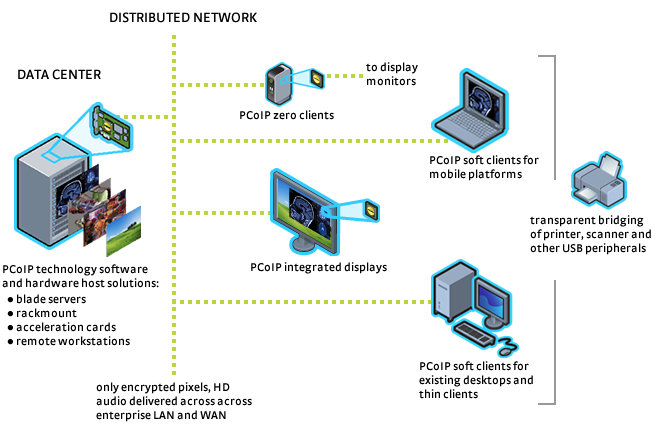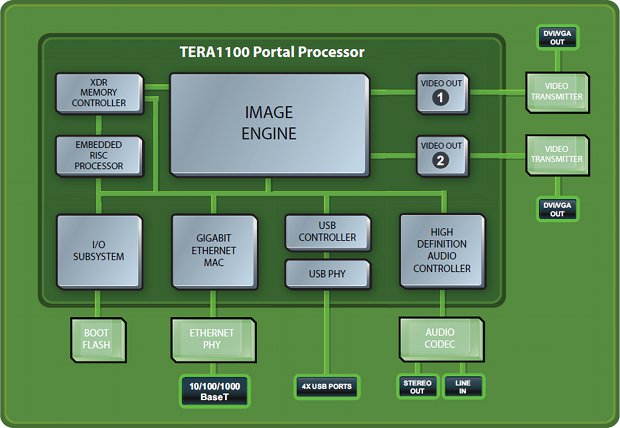Teradici has developed PCoIP (PC-over-IP) protocol, a technology that allows to run a full desktop remotely over the network on thin clients, desktops, integrated displays, laptops and even Android tablets.
The PCoIP protocol compresses, encrypts and encodes the entire computing experience at the data center and transmits it ‘pixels only’ across any standard IP network to stateless PCoIP zero clients. The PCoIP protocol is implemented in silicon for hardware accelerated performance and in software in VMware View. It supports high resolution, full frame rate 3D graphics and HD media, multiple large displays, full USB peripheral connectivity, and high definition audio all via LAN or WAN networks.
A typical network made of PCoIP clients is shown below.

Teradici emphasizes three key features of PCoIP technology:
- PCoIP technology uses host rendering
Most other remote desktop technologies uses client rendering which may not be optimal and requires somewhat powerful clients. PCoIP uses host rendering which fully preserves the PC environment and only broadcasts the encrypted pixels (not the data) across the network to the client which makes it possible to have stateless, decode-only client devices (true zero clients). This decreases maintenance and increases security as all data is kept on the server.
- PCoIP protocol is uniquely multi-codec
The PCoIP protocol continuously analyzes and decomposes image elements (graphics, text, icons, photographs, video, etc) and compresses them with the right codec for each and every pixel to minimize network bandwidth utilization.
- PCoIP protocol dynamically adapts to network conditions
The image quality settings of the PCoIP protocol can be configured to manage bandwidth use. PCoIP technology also features adaptive encoders to automatically adjust image quality on congested networks within the user-defined limits. PCoIP protocol use UDP – a real-time protocol – to reduce latency and ensure a responsive, interactive remote user experience.
If you prefer to visualize the way PCoIP protocol works, you can watch the video below which explains the three points above.
As mentioned above, Teradici is working with VMWare to implement PCoIP technology into VMWare View and there are already a number of true zero clients available on the market, many of which are VMWare-ready.
Teradici also offers 2 PCoIP processors:
- TERA1100 Portal Processor – Designed to be integrated into any user appliance or portal at the desktop, the TERA1100 Processor support 2 separate displays (DVI up to 1920×1200), features a 1 Gbit Ethernet controller, an HD Audio serial link, 4 USB ports, GPIOs as well as SMBus support.
- TERA1200 Host Processor – Designed to be integrated into datacenter equipment including PC blades, server blades, rack mount PCs, or tower PCs, the TERA1200 Host Processor support 2 video input (DVI up to 1920×1200) and features a PCI Express endpoint, a 1-Gbit Ethernet controller, an HD Audio controller interface, a USB controller interface and GPIOs, as well as SMBus support.
At CES 2012, Charbax filmed a demo of PCoIP “running” Windows 7 on an OMAP4460 Android tablet via WMWare view. At the same time, Windows 7 is shown on the HDMI display, a video conference is displayed on the tablet screen. The demo is however somewhat disappointing as they did not move the windows, so we cannot evaluate this technology performance. On the video below, the server running Windows 7 is in Vancouver, and the Android tablet in Las Vegas.
You can find further information on PCoIP technology page, and Teradici PCoIP processors page.

Jean-Luc started CNX Software in 2010 as a part-time endeavor, before quitting his job as a software engineering manager, and starting to write daily news, and reviews full time later in 2011.
Support CNX Software! Donate via cryptocurrencies, become a Patron on Patreon, or purchase goods on Amazon or Aliexpress





